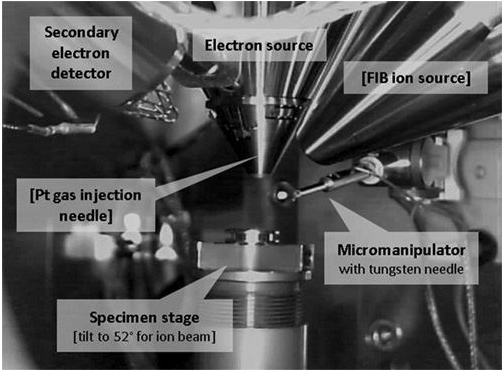Members Login

Channels
Special Offers & Promotions
The University of Bristol uses Kleindiek Micromanipulators and the Application of SEMGlu in their Research on Materials from the Japanese Nuclear Power Plant Accident at Fukushima
EM Resolutions, manufacturers and suppliers of tools and accessories for users of electron microscopes, report on the research of Peter Martin from the University of Bristol.
 He is applying Kleindiek micromanipulators in the characterisation of materials resulting from the accident at the Japanese nuclear power station.
He is applying Kleindiek micromanipulators in the characterisation of materials resulting from the accident at the Japanese nuclear power station.
PhD student, Peter Martin, is a member of the School of Physics at the University of Bristol. His research focuses on the March 2011 incident at the Fukushima Daiichi Nuclear Power Plant (FDNPP) in Japan and its effects at both the metre and micron scales. He has used an unmanned aerial vehicle to investigate the evolving distribution of contamination as well as using novel micro-analysis techniques to isolate and subsequently study tiny fragments of fallout material collected from around the crippled plant. This has potential impact on human health and the background to this is well documented from short-lived radioisotopes to longer life elements.
When he and his colleagues started the project and looked at the current state of the work surrounding the study of material ejected from the FDNPP, it became apparent the lack of work that was being conducted on individual particles of fallout material. Only a few studies were being performed on material collected from air sampling filters at a few locations close as well as further away from the plant. Previous work within the Interface Analysis Centre at the University of Bristol has extensively used Kleindiek MM3A-EM Micromanipulators (EM Resolutions, Cambridge, UK) for a range of applications (TEM sample preparation, in-situ force measurements and electrical probe-based characterisation). They saw the potential to apply the microscopy knowledge and experience within the Centre's new environmental- SEM - enabling much more efficient sample preparation and higher throughput of material. By using micromanipulators in their work, they are able to remove only the particles of interest (after identifying material under the SEM). In this way, they are able to obtain the most accurate isotopic analysis results (free from background interference) in addition to having the samples mounted for an array of further analytical techniques. Micromanipulators such as the Kleindiek MM3A-EM installed within an SEM represent the only method to remove the sub-nanometer fallout particles encountered.
When asked about his choice of manipulator, Martin said “Kleindiek MM3A Micromanipulators are used in our work for other applications as well as the “particle picking” described above. The main advantage of Kleindiek system is their flexibility in operation. Unlike other systems which provide a method of manipulating a needle, the Kleindiek platform can be used for a whole range of applications and is not limited as a niche instrument. We see it is important for us in academia to combine these advantages in a wide range of applications with the potential to also expand further on it.”
Continuing, Martin talks about the experimental methods used. “Using electrostatic attraction between objects and manipulation needles is the common way with which to “pick-up” material. However, in order to ensure that these highly active particles remain attached and do not “fall off” representing a large radiological hazard, the use of Kleindiek SEMGlu has been very important. The very high strength of this vacuum compatible adhesive, which is polymerised under the electron beam, means that the particles are well-adhered for transport and remain on the needle tip during the range of analytical techniques that are carried out on them whilst still attached to the manipulation needle (tungsten or glass). Like the Kleindiek systems in general, other uses for SEMGlu outside of "particle picking” have been explored within the group.”
The work described here is published in detail in an open-access paper in Spectrochimica Acta Part B: Atomic Spectroscopy: http://dx.doi.org/10.1016/j.sab.2015.12.010.
Media Partners


